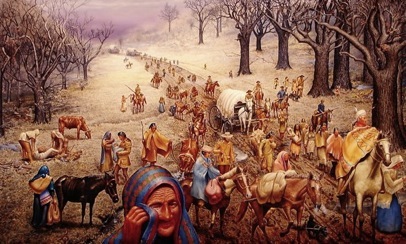Although Cherokee had long called western Georgia home, Georgian settlers continued to take Native-American Lands and force them into the frontier between 1790 and 1830. The Cherokees were not nomadic savages, but had in fact absorbed numerous European-style customs that included the wearing of gowns by Cherokee women. They constructed roads, schools and churches, possessed a method of representational government, had a printed newspaper, and many were farmers and cattle ranchers. A Cherokee alphabet, the "Talking Leaves" was developed by Sequoyah.
In 1830 the Congress of the United States passed the "Indian Removal Act." Although many Americans were against the act, most notably Tennessee Congressman Davy Crockett, it passed anyway. President Jackson quickly signed the bill into law. The Cherokees attempted to fight removal legally by challenging it in the Supreme Court, but the case was not heard. In 1832, the U.S. Supreme Court ruled in favor of the Cherokee on the same issue in Worcester v. Georgia, as Chief Justice John Marshall ruled that the Cherokee Nation was sovereign, making the removal laws invalid. It was this denial of the Indians most fundamental rights that led to a celebrated confrontation between two branches of the federal government in the persons of the venerable chief justice of the United States, John Marshall, and the president, Andrew Jackson The Cherokee would have to agree to removal in a treaty that would need ratification by the Senate.
To continue reading about the Trail of Tears, click here
To return to the home page, click here.





